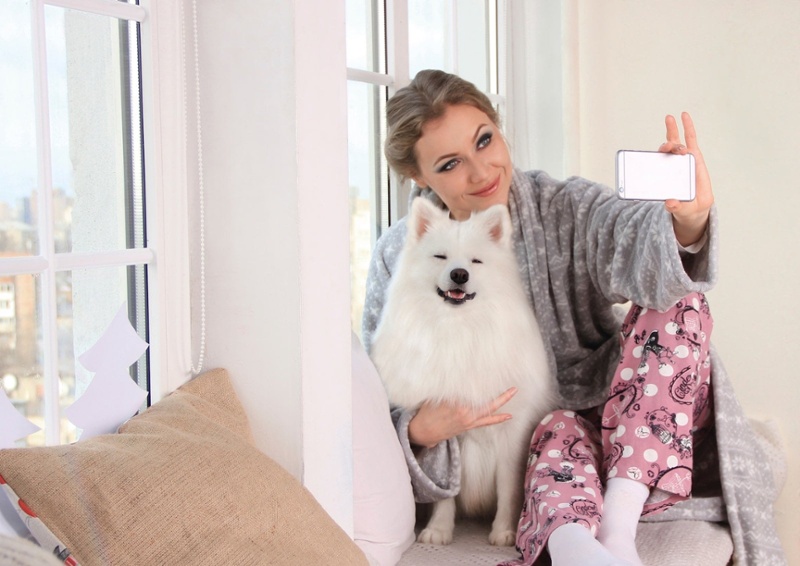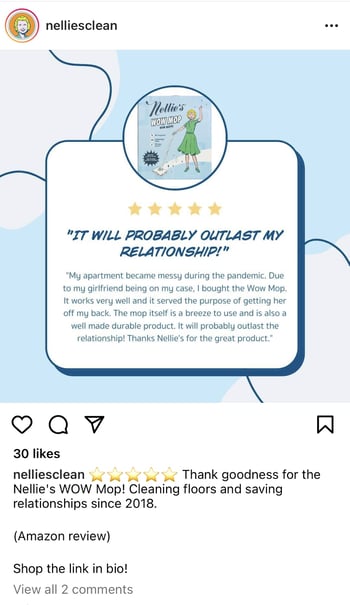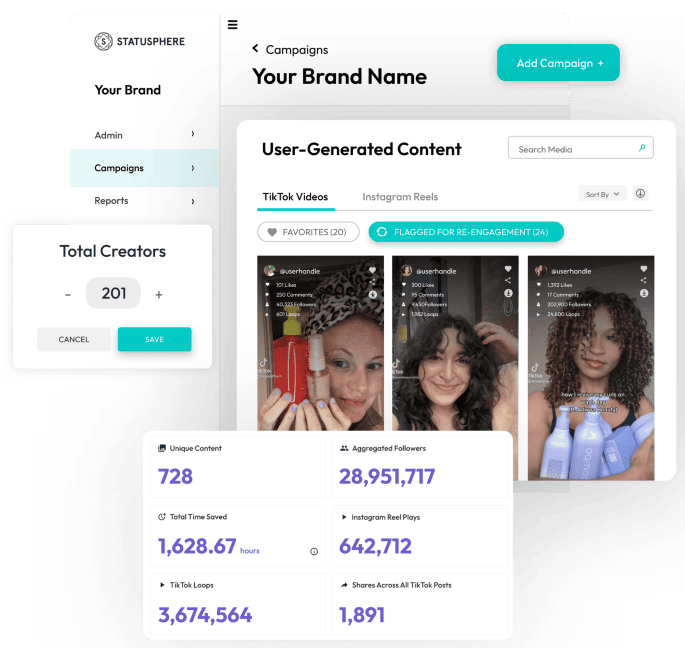Creator Licensing: How to Get Influencer Content Usage Rights
Creator licensing is a simple concept but obtaining influencer usage rights can be complicated. Here's how to streamline influencer content rights...
Need more user-generated content to promote your products? We break down eight ways to incentivize and encourage UGC from creators and customers.
.jpg)

Trying to get more user-generated content?
Good! Authentic UGC videos and photos from real customers are your best marketing assets.
Because content created by consumers for consumers is authentic and prime for social engagement. Not to mention that creator content can be seamlessly repurposed into high-performing UGC ads.
Building a library of user-generated content doesn’t happen by accident.
And getting UGC isn't a one-size-fits-all process from one channel, either.
That's why we wrote this post breaking down proven strategies to encourage UGC for your brand.
Skip to Section 👇 |
Despite popular belief, encouraging UGC doesn’t have to be a total time-sink.
The key is having multiple channels to collect UGC from creators and customers up and running.
Here are eight strategies for brands to gather more user-generated content with examples of each.
If you want ongoing UGC, promoting a branded hashtag is a low-hanging place to start.
This provides a place for customers to consistently tie their tagged posts back to your brand.
For inspiration, let’s look at how Loop invites customers to share content featuring their earplugs in the wild using the #loopearplugs hashtag. Notice how the tag is front-and-center in their Instagram bio with a specific call to action to share UGC photos and videos?


This is a brilliant example of how to get user-generated content on Instagram. The company regularly republishes content from customers on their main feed, too.

At a glance, hashtag promotion might seem like a passive way to encourage UGC.
The reality, though? Getting your hashtag off the ground requires active, ongoing promotion.
And the keyword here is to promote! Sticking a hashtag in your Instagram or TikTok bio doesn’t guarantee a flood of customer content. Getting the most out of a branded hashtag means:
Once your tag takes off, you benefit from a consistent source of fresh user-generated content.
If you want more UGC as a brand, don't be shy about it.
Peek your @tags and mentions to see opportunities to gather UGC directly. You’d be surprised at how many satisfied customers would be happy to share with you.
Most of the time, customers just need a little “push” to share their content. Check out the example below of how brands can ask for UGC and do it by the book.

This UGC example highlights the importance of content usage rights and making sure you have explicit permission from customers before you can promote their posts elsewhere. This is especially important when running UGC in ads or putting it on your website.
A little bit of competition can go a long way when it comes to getting more UGC.
Check out how Ole Henriksen invited Instagram followers to participate in a posting challenge for National No Makeup Day. The brand asked customers to go makeup-free, create a Reel documenting their natural look and tag it with #OleMadeMeDoIt.

Source: Ole Henriksen
The result? High-quality, share-worthy UGC! Customer photos like the one below only happen when a brand has a strong connection with their audience.

Source: @katiireviews
This process also highlights how hashtags are crucial to your user-generated content strategy. With a tag, you can consolidate all your UGC in one place. Beyond that, keep your eyes peeled for notifications and tagged social media posts.
Note: Make sure you understand the rules of legalese for running UGC contests and giveaways before you plan one!
We’ve all been burned by disappointing products, right?
Customer reviews provide much-needed proof to ensure people get what they pay for. Coupled with customer photos, written reviews can be an incredibly powerful type of UGC.
That’s why so many brands encourage user-generated content like photos and (even videos) in online reviews. Recent UGC statistics highlight how customer-submitted photos on product pages result in increased order values and conversion rates.
Check out how KEDS allows customers to upload photos as part of their reviews on-site:


Beauty brands like ILIA are crushing it right now when it comes to UGC on product and website pages. Check out their “See It In Real Life” review section that showcases their products in action.

Source: ILIA
Rather than scrolling through a wall of text, customers see untouched and authentic content from reviewers. These unfiltered snapshots are powerful. Not only do they signal how the brand trusts its customers but also how much loyal customers love ILIA’s products.
UGC-filled reviews also make it easier for people to visualize their products in your hands. In the case of skincare, potential customers might see someone with a similar complexion to themselves. This marketing strategy highlights how encouraging UGC can bring you closer to your customers.
Keep in mind that simply promoting your UGC can result in more UGC.
How so? Think of UGC as having a sort of snowball effect.
Sharing a customer photo, video or review serves as an unspoken incentive for others to do the same. On the flip side, you can use your customer-centric posts as a direct invitation for more UGC.
Granted you have content permissions, these interactions require relatively little effort on your part but can result in long-term loyalty. Check out how Nellie’s Clean repurposes a positive customer review on-site into a branded graphic for Instagram.

Source: @nelliesclean
See how that works?
This illustrates how to double-dip your user-generated content without as much legwork.
Below is another UGC example from Versed which features an Instagram Reel of a satisfied customer. Note how the brand tagged the creator and gave her a glowing shout-out, too.


Source: @versed
Once you’ve figured out how to get more user-generated content, don’t let it go to waste! Some of the best types of UGC videos to republish:
Note: Make sure your brand has the rights to any tagged piece of customer content before reposting it. When in doubt, contact the creator to request UGC usage rights via comments or DM. Crediting the content creator is always a smart move, too. For more tips and inspiration, check out our post breaking down the fine details of repurposing UGC.
If your brand is active on TikTok Shop, taking advantage of the platform's Open Affiliate option can open up the door for your brand to earn more UGC.
The idea here is simple. By partnering with creators who meet the requirements of TikTok Shop's affiliate program, creators are incentivized to promote products as affiliates with UGC.

Depending on your commission split and what you're selling, you can attract the attention of creators eager to show off your products in action. Doing so is a win-win for brands and creators alike.
The key is matching with the right creators among the millions of them active on TikTok.
This highlights the value of a UGC platform like Statusphere that helps match brands with relevant TikTok Shop creators and requires links to your Shop products so you get guaranteed UGC from affiliates without getting ghosted.

Sending PR packages is a proven way to activate creators and drive timely UGC when you need it the most. Check out how Rare Beauty got timely photos from gifting during a launch and promoted those photos in their Instagram Stories.


Many brands ramp up their gifting and seeding efforts with new product drops to build buzz and get authentic UGC to promote throughout their launches. The key is timing your campaigns and aligning them with launches so creators get your products early enough to post about them.
We’ve said a million times how effective creator content is for brands across social media.
That’s because the right influencers and UGC creators go above and beyond when it comes to their posts. They know what their followers want to see and how to put brands in the best light possible. Not to mention serve as the basis for high-performing UGC ads on TikTok and IG.

In terms of the types of creators to partner with, we've found that brands today benefit most from working with micro-influencers at scale.
The biggest benefit of micro-influencer content is that it retains its authenticity as these up-and-coming creators know exactly what trends and messaging click with their audiences. This results in higher-performing ads that don't feel "salesy" at all.
There’s no shortage of ways to encourage more user-generated content from your customers.
Whether you're looking for ways to scale your current UGC campaign? Need to put more effort into promoting your branded hashtags? Any combination of the tips above is fair game.
As far as the “best” method to get more UGC? It all depends on your brand's goals.
Not to mention your budget and bandwidth.
The problem? UGC can take weeks or months to build organically. For brands that need authentic content ASAP, the waiting game isn't exactly ideal. That doesn't even take into account the time spent trying to get creator permissions or conduct outreach.
That's where Statusphere comes in. Our micro-influencer platform offers brands authentic, guaranteed UGC at scale. That's because our unique matchmaking algorithm uses 250+ first-party data points to match brands with micro-influencers from our vetted network.

We have a track record of over 75,000 pieces of UGC created on behalf of 400+ brands. Whether you're interested in running UGC ads or need rights-ready content ASAP, our software can help.
Want to learn more about how our platform works? Get in touch with our team of creator marketing experts to see how we can scale your brand's UGC in a fraction of the time.

While there's no one-size-fits-all answer, some common ways for brands to get user-generated content include:
Yes! Despite popular belief, brands need permission from creators to repost, republish or otherwise promote user-generated content.
Requesting permission to use UGC can be done in a few different ways, including:
Brands can credit UGC by tagging the original creator's social handles. This is assuming you've already been granted to use their UGC.
If you're featuring UGC on a product or website, be clear whether the creator wants their full name disclosed (or if they'd prefer only showing their first name and last initial, for example).
Creator licensing is a simple concept but obtaining influencer usage rights can be complicated. Here's how to streamline influencer content rights...
UGC creators are all the rage right now! We explain who these creators are, whether they're right for your brand and the difference between UGC and...
Earning user-generated content is a top priority for brands today. These creator outreach email templates can help you collect UGC more efficiently.
Be the first to know about the latest tools, trends and strategies in influencer marketing for brands.